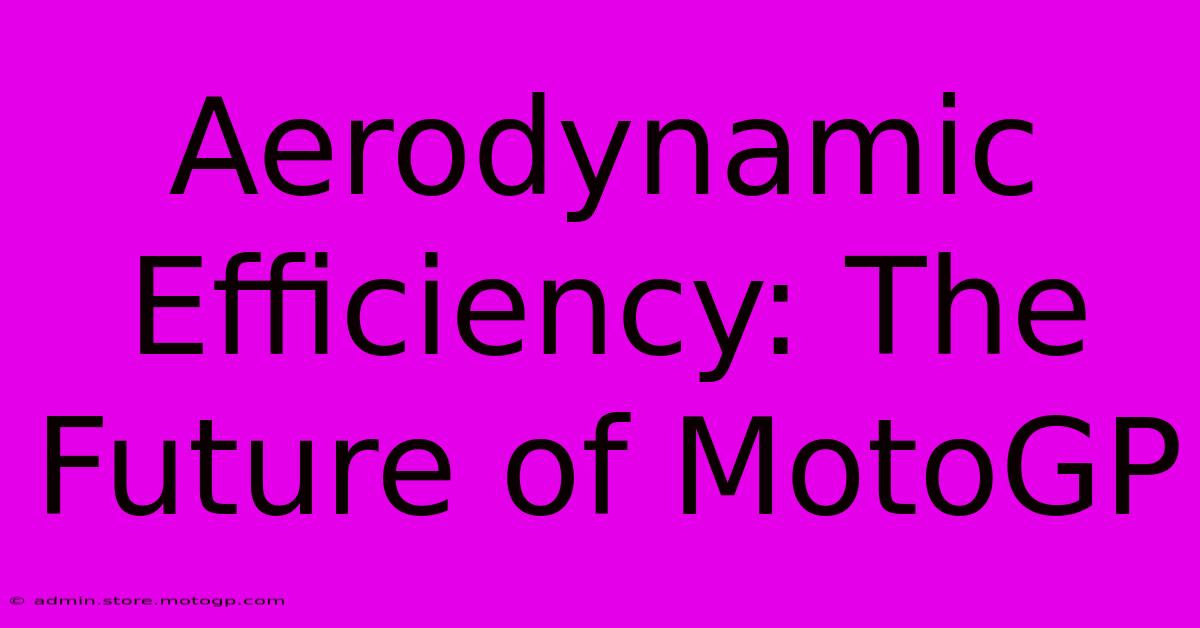Aerodynamic Efficiency: The Future Of MotoGP

Table of Contents
Aerodynamic Efficiency: The Future of MotoGP
MotoGP, the pinnacle of motorcycle racing, is a relentless pursuit of speed and performance. While horsepower and rider skill remain crucial, the aerodynamic efficiency of the machines is rapidly becoming a deciding factor, shaping the future of the sport. This article delves into the crucial role aerodynamics plays in MotoGP, exploring current advancements and predicting future trends.
The Aerodynamic Arms Race
The quest for aerodynamic advantage has sparked an intense "arms race" among MotoGP manufacturers. Each incremental improvement translates to crucial tenths of a second, the difference between victory and defeat. This isn't just about outright speed; aerodynamics impact cornering stability, braking performance, and even tire wear.
Current Aerodynamic Technologies
Modern MotoGP bikes are masterpieces of aerodynamic engineering. We see a plethora of sophisticated technologies deployed:
- Winglets and Aerodynamic Appendages: These small wings and appendages generate downforce, improving stability at high speeds and allowing for harder braking and faster cornering. Their design is constantly evolving, with teams experimenting with different shapes and configurations to optimize performance.
- Fairings and Bodywork: The overall shape of the fairing and bodywork is meticulously designed to minimize drag and maximize downforce. Computational Fluid Dynamics (CFD) plays a massive role, allowing engineers to simulate airflow and refine designs before hitting the track.
- Underbody Aerodynamics: The area beneath the bike is increasingly crucial. Teams focus on maximizing ground effect to create downforce without adding excessive drag. This often involves complex shapes and designs that manipulate airflow underneath the machine.
The Future of Aerodynamics in MotoGP
The future of MotoGP aerodynamics promises even more sophisticated technologies and strategies:
Advanced Materials and Manufacturing:
- Lightweight Composites: The use of lightweight yet incredibly strong carbon fiber composites is fundamental. Further advancements in materials science could lead to even lighter and stronger components, enhancing performance without adding weight.
- Additive Manufacturing (3D Printing): 3D printing allows for the creation of incredibly complex and intricate designs, pushing the boundaries of aerodynamic optimization. It offers unparalleled design freedom and enables rapid prototyping and testing.
Sophisticated Simulation and Data Analysis:
- Improved CFD Modeling: More accurate and powerful CFD simulations will allow engineers to explore a wider range of design options and identify optimal configurations with greater precision.
- Machine Learning and AI: The use of machine learning and artificial intelligence can analyze vast amounts of data from wind tunnels and track testing, leading to more effective design iterations and faster development cycles.
Active Aerodynamics:
- Adjustable Aerodynamic Devices: Imagine winglets or other aerodynamic components that adjust their angle or shape in real-time based on speed, track conditions, and rider input. This would allow for dynamic optimization of aerodynamic performance throughout a race. This is a game-changer with potential for significant performance gains.
The Balancing Act: Performance vs. Regulation
The relentless pursuit of aerodynamic efficiency isn't without its challenges. Governing bodies must carefully balance performance advancements with safety considerations and the need for a level playing field. Regulations are constantly updated to prevent an excessive arms race and ensure fair competition. Finding that balance will continue to be a critical aspect of MotoGP's future.
Conclusion
Aerodynamic efficiency is no longer a niche area of development; it's a core element of MotoGP competitiveness. The ongoing innovations in materials science, simulation, and active aerodynamics will dramatically reshape the sport in the years to come. The future of MotoGP promises a thrilling spectacle, with ever-evolving machines pushing the boundaries of what's possible on two wheels. The race for aerodynamic supremacy is far from over, and the next generation of MotoGP bikes will be even more breathtaking examples of technological achievement.

Thank you for visiting our website wich cover about Aerodynamic Efficiency: The Future Of MotoGP. We hope the information provided has been useful to you. Feel free to contact us if you have any questions or need further assistance. See you next time and dont miss to bookmark.
Featured Posts
-
The Insiders Guide To Cota The Ultimate Austin F1 Map
Feb 20, 2025
-
Moto Gp 23 Ps 5 The Definitive Racing Game
Feb 20, 2025
-
Cota Gear Elevate Your Fan Game
Feb 20, 2025
-
Race Like A Pro Motorcycles Available Now
Feb 20, 2025
-
Moto Gp Top Speed The Art Of Going Fast
Feb 20, 2025
